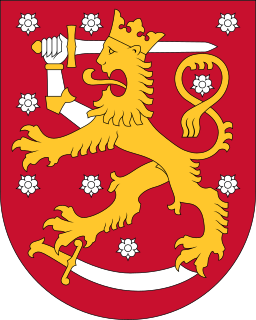
The politics of Finland take place within the framework of a parliamentary representative democracy. Finland is a republic whose head of state is President Sauli Niinistö, who leads the nation's foreign policy and is the supreme commander of the Finnish Defence Forces. Finland's head of government is Prime Minister Sanna Marin, who leads the nation's executive branch, called the Finnish Government. Legislative power is vested in the Parliament of Finland, and the Government has limited rights to amend or extend legislation. Because the Constitution of Finland vests power to both the President and Government, the President has veto power over parliamentary decisions, although this power can be overruled by a majority vote in the Parliament.
The Swedish People's Party of Finland is a political party in Finland aiming to represent the interests of the minority Swedish-speaking population of Finland. The party is currently participating in the government of Sanna Marin, holding the positions of Minister of Justice and Minister for Nordic Cooperation and Equality.
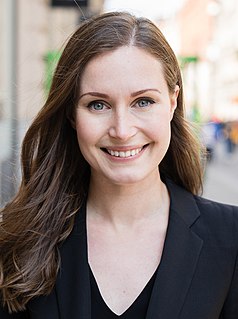
The prime minister of Finland is the head of the Finnish Government. The prime minister is Finland's head of government and is formally ranked third in the protocol after the president of Finland and the speaker of the Parliament. Finland's first prime minister was Pehr Evind Svinhufvud, was appointed on 27 November 1917, just a few days before the country became independent.
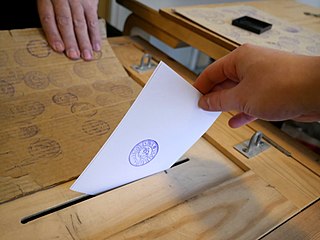
There are four types of elections in Finland. Each Finnish citizen at least 18 years of age has the right to vote in each of the elections, which decide the following: the president, the parliament, the MEPs, and the municipal and city councils.

Karl-August Fagerholm was Speaker of Parliament and three times Prime Minister of Finland. Fagerholm became one of the leading politicians of the Social Democrats after the armistice in the Continuation War. As a Scandinavia-oriented Swedish-speaking Finn, he was believed to be more to the taste of the Soviet Union's leadership than his predecessor, Väinö Tanner. Fagerholm's postwar career was, however, marked by fierce opposition from both the Soviet Union and the Communist Party of Finland. He narrowly lost the presidential election to Urho Kekkonen in 1956.
A minister is a politician who heads a ministry, making and implementing decisions on policies in conjunction with the other ministers. In some jurisdictions the head of government is also a minister and is designated the ‘prime minister’, ‘premier’, ‘chief minister’, ‘chancellor’ or other title.
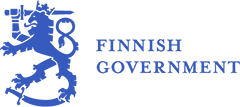
The Finnish Government is the executive branch and cabinet of Finland, which directs the politics of Finland and is the main source of legislation proposed to the Parliament. The Government has collective ministerial responsibility and represents Finland in the Council of the European Union. In the incumbent Marin Cabinet, the Government comprises 19 ministers leading 12 ministries.
The Minister for Foreign Affairs handles the Finnish Government's foreign policy and relations, and is in charge of the Ministry for Foreign Affairs. The Minister for Foreign Trade and Development is also associated with this ministry.

The first cabinet of Paavo Lipponen was the 66th government of Finland, which existed from 13 April 1995 to 15 April 1999. The cabinet’s Prime Minister was Paavo Lipponen. It was a majority government, and one of the longest-running governments in Finnish history. Lipponen's first government ran for a whole term of a Finnish cabinet, or 1 464 days in total. The cabinet was composed of a coalition formed by the Social Democratic Party, the National Coalition Party, the Swedish People's Party, the Left Alliance, and the Green League. Due to the cabinet containing five separate parties from all over Finland's political spectrum, both of Lipponen's cabinets were considered rainbow coalitions.
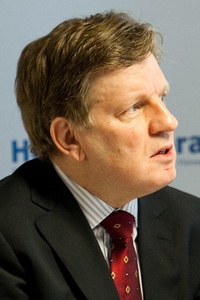
The cabinet of Esko Aho was the 65th government of Finland. The cabinet existed from 26 April 1991 to 13 April 1995. The cabinet’s Prime Minister was Esko Aho.

The second cabinet of Matti Vanhanen was the 70th cabinet and Government of Finland. The cabinet held office from 19 April 2007 to 20 June 2010. The cabinet was a centre-right-led coalition, consisting of four parties: the Centre Party, the National Coalition Party, the Green League and the Swedish People's Party.
Anu Helena Vehviläinen is a Finnish politician for the Centre Party who has been serving as Speaker of the Finnish Parliament since 2020. She previously held various cabinet positions, including as Finland's Minister of Local Government and Public Reforms in the Sipilä Cabinet from 2015 to 2019; as Minister of Transport from May to June 2019; and as Minister of Transport in the Vanhanen II and Kiviniemi cabinets from 2007 to 2011.
Toivo Kivimäki's cabinet was the 20th government of Republic of Finland. Cabinet's time period was from December 14, 1932 to October 10, 1936. It was Minority government. Many of the neutral ministers were members of the National Coalition Party without formal support of the party. Cabinet fell in 1936 by the interpellation of the opposition after its bill to reinstate the capital punishment had failed to pass. Kivimäki's cabinet was the longest government in Finland until 1987 Kalevi Sorsa's fourth cabinet.
Karl-August Fagerholm's third cabinet was the 44th government of Republic of Finland. Cabinet's time period was from September 29, 1958 to January 13, 1959. It was Majority government.

The Katainen Cabinet was the 72nd cabinet of Finland, formed as a result of the 2011 post-parliamentary election negotiations between the Finnish parliamentary parties. Led by Prime Minister Jyrki Katainen of the National Coalition Party (NCP), 12 ministers of the 19-minister government represented the NCP and the Social Democratic Party (SDP), while the Left Alliance, the Green League, the Swedish People's Party (RKP) and the Christian Democrats share seven minister portfolios. On June 22, the Parliament confirmed Katainen's election as the Prime Minister and President Tarja Halonen inaugurated the government. Two Left Alliance MPs voted against Katainen, for which they were formally reprimanded by the Left Alliance's parliamentary group. On 25 March 2014, the rest of Left Alliance left the cabinet over dispute on a package of spending cuts and tax rises.

A cabinet is a body of high-ranking state officials, typically consisting of the executive branch's top leaders. Members of a cabinet are usually called cabinet ministers or secretaries. The function of a cabinet varies: in some countries, it is a collegiate decision-making body with collective responsibility, while in others it may function either as a purely advisory body or an assisting institution to a decision-making head of state or head of government. Cabinets are typically the body responsible for the day-to-day management of the government and response to sudden events, whereas the legislative and judicial branches work in a measured pace, in sessions according to lengthy procedures.

The Social Democratic Party of Finland, shortened to the Social Democrats and commonly known in Finnish as Demarit, is a social-democratic political party in Finland. It is currently the largest party in the Parliament of Finland with 40 seats.
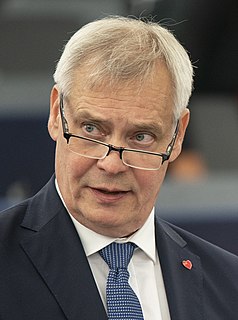
The cabinet of Antti Rinne was the 75th government of Finland. It was formed following the parliamentary election of 2019 and was formally appointed by President Sauli Niinistö on 6 June 2019. The cabinet consisted of a coalition formed by the Social Democratic Party, the Centre Party, the Green League, the Left Alliance, and the Swedish People's Party. The cabinet's Prime Minister was Antti Rinne.
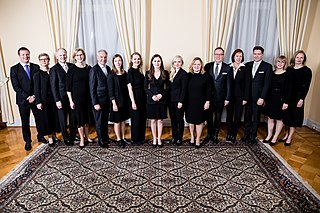
The cabinet of Sanna Marin is the incumbent 76th government of Finland. It was formed following the collapse of the Rinne Cabinet and officially took office on 10 December 2019. The cabinet consists of a coalition formed by the Social Democratic Party, the Centre Party, the Green League, the Left Alliance, and the Swedish People's Party.













